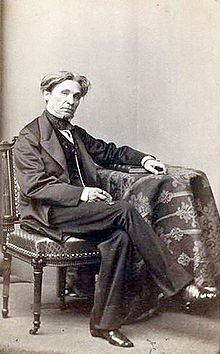| Fyodor Bruni | |
|---|---|
 Portrait photograph by Andrey Denyer, c. 1865 Portrait photograph by Andrey Denyer, c. 1865 | |
| Born | Fidelio Bruni (1799-06-10)10 June 1799 Milan |
| Died | 30 August 1875(1875-08-30) (aged 76) Saint Petersburg |
| Resting place | Tikhvin Cemetery, Saint Petersburg |
| Education | Member Academy of Arts (1834) Professor by rank (1836) |
| Alma mater | Imperial Academy of Arts |
| Notable work | The Brazen Serpent, 1833–1841 |
| Spouse |
Angelica Serni (m. 1835) |
| Patron(s) | Alexei Yegorov, Andrey Ivanov, Vasily Shebuyev |
Fyodor (Fidelio) Antonovich Bruni (Russian: Фёдор Антонович Бруни; 10 June 1799 – 30 August 1875) was a Russian artist of Swiss Italian descent who worked in the Academic style.
Biography
His father, Antonio, was a Swiss Italian painter and art restorer who relocated to Russia in 1800 to work on a project at Saint Michael's Castle for Tsar Paul I. At the age of ten, he was enrolled at the Imperial Academy of Arts, where he studied with Alexei Yegorov, Andrey Ivanovich Ivanov and Vasily Shebuyev. He graduated in 1818 with the title "Artist Class XIV".

His father, believing that a Russian art education was insufficient, sent him for further studies in Italy. At the age of twenty-two, he created his first large-scale work ("The Death of Camilla"), which was exhibited in the Capitol. Ten years later, when the painting was shown in Saint Petersburg for the first time, it earned him the title of Academician. In the early 1830s, he began a monumental painting of "Moses Exalting the Brazen Serpent", but before its completion he was recalled to Saint Petersburg to work on a project at Saint Isaac's Cathedral and teach at the Academy. He arrived in 1836 and produced several works for the Kazan Cathedral as well. Mikhail Botkin and Arseny Meshchersky were among his first students at the Academy.
In 1838, he was able to return to Rome to finish his work on Moses and the Serpent. Two years later, it was completed and moved to Saint Petersburg where it was exhibited in one of the halls of the newly restored Winter Palace. It is now the largest canvas on display at the Russian Museum. Returning to Rome for a third time from 1841 to 1845, he produced twenty-five sketches that would be the basis for frescoes at Saint Isaac's Cathedral. Some of the frescoes were executed by Bruni himself, others by various artists under his direction. The work was completed in 1853 and the originals are now stored at the Russian Museum.
In 1849, he became the custodian of the gallery at the Hermitage Museum and was sent abroad twice to acquire paintings for the collection there. Six years later, he became Rector of the Department of Sculpture and Painting at the Academy.
As he grew older, however, he became reclusive; even distancing himself from his own students and disappearing for weeks at a time. In his efforts to sustain the academic tradition, he began to openly express his dislike for younger artists and was forced to resign in 1871 because of his behavior. By the time of his death, he was an honorary Professor at the Florence Academy of Fine Arts and the Accademia di San Luca in Rome.
References

- ^ Russian Wikisource: Biography from the Brockhaus and Efron Encyclopedic Dictionary
- ^ RusArtNet: Biography
- Russian Museum website Archived 2014-08-08 at the Wayback Machine
- ^ Русская живопись (Russian Painting): Biography
Further reading
- General studies
- Polovtsov, Anatoly V. (1907). Федор Антонович Бруни (in Russian). St. Petersburg: Imperial Academy of Arts. OCLC 3595202.
- Savinov, Alexei N. (1954). "Федор Антонович Бруни". In Leonov, Alexei I. (ed.). Русское искусство: очерки о жизни и творчестве художников. Первая половина девятнадцатого века (in Russian). Moscow: Iskusstvo. pp. 471–486. OCLC 489749250.
- Somov, Andrei I. (September 26, 1875). "Федор Антонович Бруни (1800–1875)". Pchela (in Russian). Vol. 1, no. 35. pp. 425–427.
- Vereshchagina, Alla G. . Федор Антонович Бруни (in Russian). Leningrad: Khudozhnik RSFSR. OCLC 185750139.
- Reference books
- Bryan, Michael (1886). Graves, Robert Edmund (ed.). Dictionary of Painters and Engravers, Biographical and Critical. Vol. I: A-K. London: George Bell and Sons. p. 191.
- Grekov, Vladimir (1908). "Бруни, Федор Антонович". In Polovtsov, Alexander A. (ed.). Russian Biographical Dictionary (in Russian). Vol. 3. Saint Petersburg: Main Department for the Udels. pp. 368–371.
- Milner, John (1993). A Dictionary of Russian and Soviet Artists, 1420–1970. Woodbridge, Suffolk: Antique Collectors' Club. p. 91. ISBN 1-85149-182-1. OCLC 29787870.
- Muratov, Aleksandr M. (2006). "Бруни Фёдор (Фиделио) Антонович". In Osipov, Yury S. (ed.). Great Russian Encyclopedia (in Russian). Vol. 4. Moscow: Bolshaya Rossiyskaya Entsiklopediya. p. 249. ISBN 5-85270-333-8. Archived from the original on January 31, 2022.
- Neumann, Wilhelm (1911). "Bruni, Feodor (Fidelio) Antonowitsch". In Thieme, Ulrich (ed.). Allgemeines Lexikon der bildenden Künstler (in German). Vol. 5. Leipzig: E. A. Seemann. p. 137. OCLC 1039525112.
- Petrushevsky, Fyodor F. (1891). "Бруни (Федор Антонович)". Brockhaus and Efron Encyclopedic Dictionary (in Russian). Vol. IVa. St. Petersburg: Brockhaus and Efron. pp. 752–753.
- Printseva, Galina A. (1996). "Bruni, Fyodor [Fidelio] (Antonovich)". In Turner, Jane (ed.). The Dictionary of Art. Vol. 5. New York: Grove's Dictionaries. pp. 25–26. ISBN 1-884446-00-0. OCLC 1033664864 – via the Internet Archive.
External links
[REDACTED] Media related to Fyodor Bruni at Wikimedia Commons
- Fyodor Bruni at the Russian Academy of Arts' official website (in Russian)
- Members of the Imperial Academy of Arts
- Academic staff of the Imperial Academy of Arts
- Imperial Academy of Arts alumni
- 19th-century Italian painters
- 19th-century painters from the Russian Empire
- Male painters from the Russian Empire
- Italian male painters
- Immigrants to the Russian Empire
- Artists from Milan
- 1799 births
- 1875 deaths
- Burials at Tikhvin Cemetery
- 19th-century Italian male artists
- 19th-century male artists from the Russian Empire